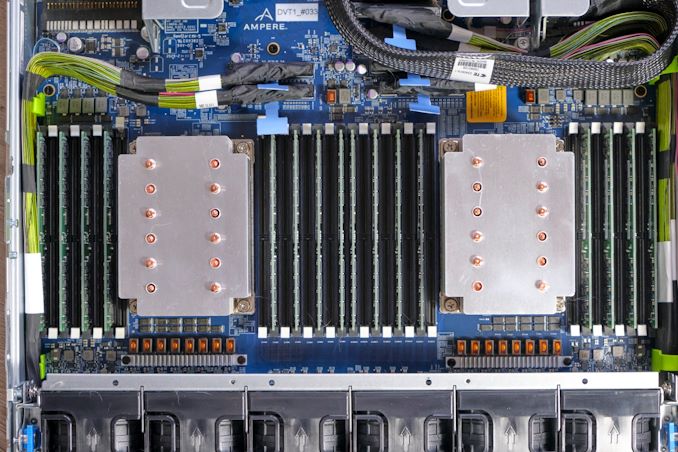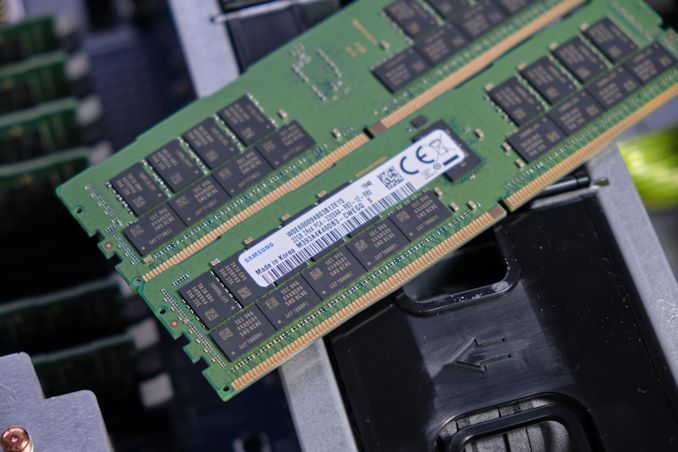The Ampere Altra Review: 2x 80 Cores Arm Server Performance Monster
by Andrei Frumusanu on December 18, 2020 6:00 AM EST- Posted in
- Servers
- Neoverse N1
- Ampere
- Altra
Test Bed and Setup - Compiler Options
For the rest of our performance testing, we’re disclosing the details of the various test setups:
Ampere "Mount Jade" - Dual Altra Q80-33
Obviously, for the Ampere Altra system we’re using the provided Mount Jade server as configured by Ampere.
The system features 2 Altra Q80-33 processors within the Mount Jade DVT motherboard from Ampere.
In terms of memory, we’re using the bundled 16 DIMMs of 32GB of Samsung DDR4-3200 for a total of 512GB, 256GB per socket.
| CPU | 2x Ampere Altra Q80-33 (3.3 GHz, 80c, 32 MB L3, 250W) |
| RAM | 512 GB (16x32 GB) Samsung DDR4-3200 |
| Internal Disks | Samsung MZ-QLB960NE 960GB Samsung MZ-1LB960NE 960GB |
| Motherboard | Mount Jade DVT Reference Motherboard |
| PSU | 2000W (94%) |
The system came preinstalled with CentOS 8 and we continued usage of that OS. It’s to be noted that the server is naturally Arm SBSA compatible and thus you can run any kind of Linux distribution on it.
Ampere makes special note of Oracle’s active support of their variant of Oracle Linux for Altra, which makes sense given that Oracle a few months ago announced adoption of Altra systems for their own cloud-based offerings.
The only other note to make of the system is that the OS is running with 64KB pages rather than the usual 4KB pages – this either can be seen as a testing discrepancy or an advantage on the part of the Arm system given that the next page size step for x86 systems is 2MB – which isn’t feasible for general use-case testing and something deployments would have to decide to explicitly enable.
The system has all relevant security mitigations activated, including SSBS (Speculative Store Bypass Safe) against Spectre variants.
AMD - Dual EPYC 7742
For our AMD system, unfortunately we had hit some issues with our Daytona reference server motherboard, and moved over to a test-bench setup on a SuperMicro H11DSI0.
We’re also equipping the system with 256GB per socket of 8-channel/DIMM DDR4-3200 memory, matching the Altra system.
| CPU | 2x AMD EPYC 7742 (2.25-3.4 GHz, 64c, 256 MB L3, 225W) |
| RAM | 512 GB (16x32 GB) Micron DDR4-3200 |
| Internal Disks | OCZ Vector 512GB |
| Motherboard | SuperMicro H11DSI0 |
| PSU | EVGA 1600 T2 (1600W) |
As an operating system we’re using Ubuntu 20.10 with no further optimisations. In terms of BIOS settings we’re using complete defaults, including retaining the default 225W TDP of the EPYC 7742’s, as well as leaving further CPU configurables to auto, except of NPS settings where it’s we explicitly state the configuration in the results.
The system has all relevant security mitigations activated against speculative store bypass and Spectre variants.
Intel - Dual Xeon Platinum 8280
For the Intel system we’re also using a test-bench setup with the same SSD and OS image actually – we didn’t have enough RAM to run both systems concurrently.
Because the Xeons only have 6-channel memory, their maximum capacity is limited to 384GB of the same Micron memory, running at a default 2933MHz to remain in-spec with the processor’s capabilities.
| CPU | 2x Intel Xeon Platinum 8280 (2.7-4.0 GHz, 28c, 38.5MB L3, 205W) |
| RAM | 384 GB (12x32 GB) Micron DDR4-3200 (Running at 2933MHz) |
| Internal Disks | OCZ Vector 512GB |
| Motherboard | ASRock EP2C621D12 WS |
| PSU | EVGA 1600 T2 (1600W) |
The Xeon system was similarly run on BIOS defaults on an ASRock EP2C621D12 WS with the latest firmware available.
The system has all relevant security mitigations activated against the various vulnerabilities.
Compiler Setup
For compiled tests, we’re using the release version of GCC 10.2. The toolchain was compiled from scratch on both the x86 systems as well as the Altra system. We’re using shared binaries with the system’s libc libraries.












148 Comments
View All Comments
mode_13h - Sunday, December 20, 2020 - link
There's a youtube video of some guy running Blender on a Pi v4.Der Keyser - Friday, December 18, 2020 - link
This in interesting times indeed... The question is what having Aarch64 available on very nice desktops/labtops from Apple will do in terms of incentivising devs to work with ARM? Knowing that servers with compute power/socket that equals or outperforms x86 @ lower prices must appeal to a lot of java and cloudvendor workloads.Oxford Guy - Friday, December 18, 2020 - link
Since Ampere should be able to run Crysis very well I expected to see that in the benchmarks.mode_13h - Sunday, December 20, 2020 - link
Try it under x86 emulation on the M1 and let us know how it goes.akmittal - Friday, December 18, 2020 - link
Year of ARM on servermode_13h - Sunday, December 20, 2020 - link
Starting with Graviton2 and ending with this, it's certainly the year they arrived on the scene.Oxford Guy - Friday, December 18, 2020 - link
'Where Ampere and the Altra definitely is beating AMD in is TCO, or total cost of ownership. Taking the flagship models as comparison points – the Q80-33 costs only $4050 which generally matching the performance of AMD’s EPYC 7742 which still comes in at $6950, essentially 42% cheaper.'Does per-core licensing cut into that advantage at all?
Spunjji - Monday, December 21, 2020 - link
Where it comes into play, for surename99 - Friday, December 18, 2020 - link
"it’s also a piece of hardware that the general public cannot access outside of Amazon’s own cloud services"This is no longer *technically* true:
https://aws.amazon.com/blogs/aws/reinvent-2020-pre...
Soon you should be able to buy an AWS Outpost with Graviton2 inside which kinda sorta straddles the line between "owning" and "accessed via Amazon cloud services".
watersb - Friday, December 18, 2020 - link
Wow. There's a lot to learn here.Very excited to receive me Apple M1 MacBook Pro. I hope it gives me some perspective on how performance can be applied to scientific local workstation computing.